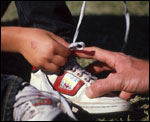Kindergarten is starting next week, and the worn-out old sneakers from last spring are pinching my daughter’s toes. No shoes fit at our favorite used-clothing store, and no neighbors have the right pair of outgrown sneakers to offer this season. There is no avoiding it. One morning, as early as I can manage, I load Jenna and her little sister into the car. We are going shoe shopping.

I thought we were getting an early start, but this is “Back To School Specials Week” and the store is crowded. We stand before the display rack, immobilized at first by the dozens of options lined up on the wall. Black, blue, purple, pink, white, red; plain or covered with butterflies, ponies, baseballs, fire trucks; embroidered or studded with flashing lights; fastened with Velcro or buckles or laces. The laces are plain or beaded. The beads are stars or dinosaurs or flowers or bats.
Jenna begins to pick up the shoes off of their Plexiglas stands. I can see the question forming in the way she lifts them up and sets them down so thoughtfully. Which style does she want? Which will show the world — her new classmates, her new teacher — who she is? I want to stop her, to derail that train of thought. I want her to know herself, her true worth, her unalterable value. She is the child who runs fast downhill with flying braids. She is the girl who crawls into the chicken coop on her belly to grab a squawking hen day after day, until it will eat grain from her hand and sit in her lap. She is the one who smiles with a dimple and can always think of one more question. Flashing lights and sparkling beads add nothing to all of this.

Straight to the source: a Vietnam sweatshop.
Photo: Dara O’Rourke.
But I don’t say anything. She does need shoes. It will soon be too cold for her sandals, which are the only shoes that fit her now. I don’t know what else to do, where else to go, so we sit down on a bench to try on some shoes. While she strides off to a mirror, I ask the salesperson if any of the shoes scattered at our feet are made in the U.S. He shrugs. I can’t tell if he is tired of the question or tired of fitting shoes. “Some of these companies used to manufacture in the states,” he says, “but not anymore. They can’t compete. Unless you want a very expensive handmade kind of shoe, you won’t find anything made in the U.S.”
I want to ask him who made the shoes Jenna is standing in now. I picture a child in Indonesia, a teenager in the Dominican Republic. I want to ask if he knows how much of my $36 the assembler earned. But his tiredness defeats me. I think he owns this store, and in the fluorescent “buy one get one free” sign on the door I can see his struggle to survive in a town that now hosts Wal-Mart, K-Mart, BJs, and Ames.
Eventually we settle on some sneakers that satisfy my daughter. They seem sturdy and fit well. They are white, with pink hearts. They have no beads, but in a long and complex negotiation, we agree to buy two sets of shoelaces (stars and flowers) to be laced on at home.
Always before when I’ve thought of sneakers, I’ve thought of their costs to others, the impact of the solvents and plastics, the fossil fuel to transport them, the injustice to the assemblers. But driving home I feel a sadness that is more personal than any of that.

Tie one on.
I can’t shake the feeling that my daughter’s sense of her own completeness within herself has just shifted. Now that she likes the idea of herself in white-and-pink sneakers with hearts, I worry that she will come to like her real, sneakerless self correspondingly less. I worry that she will come to need things to feel happy.
But children are resilient, and this story has a postscript. Two days later Jenna wears her new shoes to play hide-and-seek in a field of buckwheat. The sneakers, laces and hearts and all, turn brownish green. She is mildly sad, but nowhere near broken-hearted.
I like the shoes better this way, probably because I can see a little hope in them now. My girl who runs fast down hills is still here, pink sneakers or not. Our real selves are pretty tough, and they have a way of shining through. They don’t just vanish with the first glimpse of pale-blue ponies and flashing soccer balls.
But right now, in this culture, the ponies and flashing lights are everywhere, and I am starting to understand that one of my jobs with my children is to help them keep track of their real selves. For now, I think that means spending more time running through the buckwheat and less time asking them to choose among shoes or toys or brands of crackers. And in a few years, I think that it might mean asking, at just the right moment, in front of some tantalizing display of shoes (or jeans, or jewelry), “Can you depend on this to make you happy? Will the way that you play the drums, or write a poem, or take care of your friends change if you choose these shoes over those?”
I can already hear them saying, “Oh Mom!” and see them rolling their eyes, but I think they will have some thoughts on the subject, and I intend to listen with all my heart.


